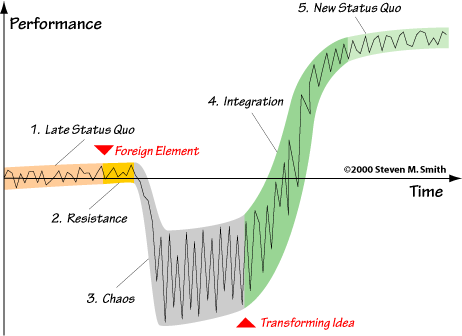Jun 21, 2013

Virginia Satir was a psychologist. She studied (among other things) how groups interact under the stress of change. The picture above is a typical Satir Change Diagram.
When you give it a quick look, time is shown along the X-axis. You see the group/team/organization is operating at some level before some “foreign element” or “change agent” appears and changes the system, throwing the team into a state of chaos. The team flounders in chaos, but if they persist they can climb out the other side, presumably to some higher state.
What does this imply for adopting scrum?
There will be pain. It will get worse before it gets better.
Corollary – if you aren’t feeling the pain, you probably did something wrong (see Larman’s 2nd Law)
The state on the other side better be worth all this pain!
While in the “chaos” state, the desire to retreat is large. The longer you flounder in chaos, the stronger the desire to backpedal.
… therefore, cross the chaos gap as quickly as possible.
Adopting incremental bits & pieces guarantees maximizing the pain and minimizing the chances of getting across the painful chaos.
get help to pull your team(s) across
Viewed another way, this is a restatement of the Tuckman model (forming/storming/norming). Both are cyclical in the sense that this is a reoccurring pattern that teams will progress through as they grow in maturity.
Interestingly, Virginia Satir was noted for her work in family psychology.